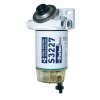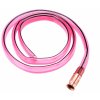Looks like it is time to replace the fuel tank in our 1983 Model 2200 Glasply Express Cruiser. The Al tank is approaching or at end of life and is factory original. Dimensions are 72inches x 22 inches and for depth has a v-shaped bottom that is 12 inches in the center and 10.5 inches on the sides. There are 5 holes/2 outlets/filler/vent/sender on the top of the tank.
Currently we are looking for someone to fabricate and weld us up a replacement tank to DOT specifications, pressure testing etc. and have a line on a couple of options, as so far there does not seem to be any off the shelf options in either plastic or Al. The weight of this keel line tank I believe adds considerable ballast and contributes to boat stability so we don’t want to go smaller and the location of the inlets/outlets is also important to match up to the design of the boat.
We are looking at a couple of options and if anyone knows of anyone else who would be good at building a tank in the south VI area or has a line on an off the shelf option I would appreciate suggestions.
The good news is that there is complete access to the tank and its mounts with the removal of the full length glassed screwed down wood cover. The bad news is that the filler and vent hose replacement looks like it will be a pain. It may be necessary to cut an access port in the deck into a chamber to route the new filler hose etc.
The tank is currently siting on a pad of what one assumes is fuel resistant cushioning material of some sort and rests on shallow fiberglass ribs attached/built into the inside of the glass hull. Anyone know what this cushioning material is and where you can get it, assuming it is necessary to replace it?
Basically there are two jobs here, the building of the tank and the removal and replacement of the tank and installation of new hoses for the filler and the vent hose. The outlet hoses/clamps have already been replaced as has the filler cap assembly.
The issue is how much can be done with the help of my more skilled fishing buddies and if there is someone in the Sooke area with good shipwright skills who could come to the boat which is on land storage and work on it at reasonable/fair cost for both of us.
This is a first for us, so any advice/suggestions, recommendations would be appreciated.
Step one, siphon out the fuel.
Currently we are looking for someone to fabricate and weld us up a replacement tank to DOT specifications, pressure testing etc. and have a line on a couple of options, as so far there does not seem to be any off the shelf options in either plastic or Al. The weight of this keel line tank I believe adds considerable ballast and contributes to boat stability so we don’t want to go smaller and the location of the inlets/outlets is also important to match up to the design of the boat.
We are looking at a couple of options and if anyone knows of anyone else who would be good at building a tank in the south VI area or has a line on an off the shelf option I would appreciate suggestions.
The good news is that there is complete access to the tank and its mounts with the removal of the full length glassed screwed down wood cover. The bad news is that the filler and vent hose replacement looks like it will be a pain. It may be necessary to cut an access port in the deck into a chamber to route the new filler hose etc.
The tank is currently siting on a pad of what one assumes is fuel resistant cushioning material of some sort and rests on shallow fiberglass ribs attached/built into the inside of the glass hull. Anyone know what this cushioning material is and where you can get it, assuming it is necessary to replace it?
Basically there are two jobs here, the building of the tank and the removal and replacement of the tank and installation of new hoses for the filler and the vent hose. The outlet hoses/clamps have already been replaced as has the filler cap assembly.
The issue is how much can be done with the help of my more skilled fishing buddies and if there is someone in the Sooke area with good shipwright skills who could come to the boat which is on land storage and work on it at reasonable/fair cost for both of us.
This is a first for us, so any advice/suggestions, recommendations would be appreciated.
Step one, siphon out the fuel.
Last edited:


